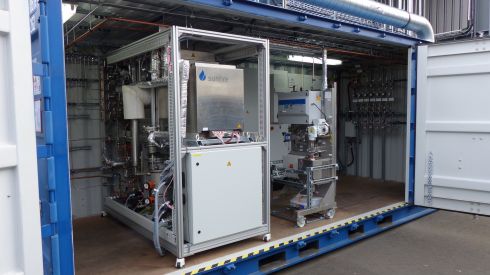Breaktrough for Power-To-X: Sunfire puts first Co-Electrolysis into operation and starts scaling
Successful start-up and test run of a high-temperature co-electrolysis system at the Dresden site since November 2018

- Highly efficient production of clean synthesis gas for PtX projects via high-temperature co-electrolysis
- Co-electrolysis prototype (10 kW DC) was developed within the framework of the BMBF-funded project Kopernikus Power-to-X / delivery to KIT in the first quarter of 2019
- Sunfire is now aiming for rapid scaling and commercialisation for project partners such as Nordic Blue Crude in Norway / Goal: Further reduce investment and operating costs.
Sunfire GmbH achieves a technological breakthrough for the energy revolution: Successful start-up and test run (>500 hours) of a high-temperature co-electrolysis system at the Dresden site since November 2018.
The technology, called SUNFIRE-SYNLINK, enables highly efficient production (in future approx. 80% efficiency on an industrial scale) of synthesis gas in a single step using water, CO2 and green electricity. This significantly reduces investment and operating costs for Power-to-X projects (e-Crude, e-fuels).
Sunfire achieved the technological breakthrough within the framework of the Kopernikus project Power-to-X (03SFK2Q0), funded by the German Federal Ministry of Education and Research, in conjunction with the Karlsruhe Institute of Technology (KIT). The successfully running co-electrolysis plant (10 kilowatts DC, up to 4 Nm³/h synthesis gas) will be delivered to Karlsruhe in the next few weeks, where it will be combined with technologies from Climeworks (Direct Air Capture), INERATEC (Fischer-Tropsch Synthesis) and KIT (Hydrocracking) in a container to produce a self-sufficient facility. The aim is to demonstrate the integrated production of e-Crude, a synthetic crude oil substitute, by the end of August 2019 – the first in a 2-step process of this magnitude made possible by co-electrolysis.
Commercialisation of Co-electrolysis for the Norway project
Furthermore, on 1 January 2019, Sunfire began the process of scaling-up the high-temperature co-electrolysis process to an industrial scale – initially with an input power of 150 kilowatts (DC) – as part of the “SynLink” project (03EIV031A) funded by the Federal Ministry of Economics and Energy. This multipliable co-electrolysis module is to be used by Nordic Blue Crude, the Norwegian project partner. The first commercial plant is to be built there, and will produce 10 million litres or 8,000 tonnes of the synthetic crude oil substitute e-Crude annually on the basis of 20 megawatts of input power.
If the Heroya Industrial Park plant goes into operation, about 21,000 tonnes of CO2 emissions will be avoided per year, given the use of both waste heat from industrial processes and environmentally friendly hydroelectric energy. This could fully power 13,000 passenger cars with synthetic eco-fuel.
Background: High Temperature Co-Electrolysis
In previous power-to-liquids processes, two separate process steps were used to break water vapour down into its components, hydrogen and oxygen (electrolysis), and to turn carbon dioxide into carbon monoxide (reverse water-gas-shift reaction). With Sunfire’s co-electrolysis, H2 (hydrogen) and CO (carbon monoxide) can now be recovered in a single process step, significantly improving the efficiency of the overall process and lowering investment (CAPEX) and operating costs (OPEX). In addition, the single-stage SUNFIRE-SYNLINK technology noticeably reduces the amount of space required.
Thanks to the global transformation of energy systems and commitments to Paris’ climate protection targets, Sunfire technologies have great global market potential. The global demand for electrolysis technologies to produce green, renewable hydrogen is estimated at more than 3,000 gigawatts. Furthermore, many sectors, like long-distance road transport, air or sea transport require alternatives to fossil diesel and kerosene, which e-fuels can provide, thanks to their excellent transportability through existing infrastructures.
In addition to the production of fuels, synthesis gas attracts customers from a wide range of industries, such as the chemical industry, plastics production or the cosmetics sector, for example. Until now, synthesis gas has mainly been produced on the basis of natural gas for industrial use; in the future, it will be produced in a CO2-neutral manner through Sunfire’s highly efficient co-electrolysis process.
New Technology Partner Paul Wurth SA
Recently, Sunfire, one of the world’s most innovative energy companies, acquired a new lead investor and technology partner in Paul Wurth, the world’s top mechanical and plant engineering company for the metals industry. The investment round, which involved former investors, yielded an additional 25 million Euros in venture capital. Sunfire will use the money to implement commercial multi-megawatt electrolysis and Power-to-X projects.
Source: Sunfire, press release, 2019-01-15.
